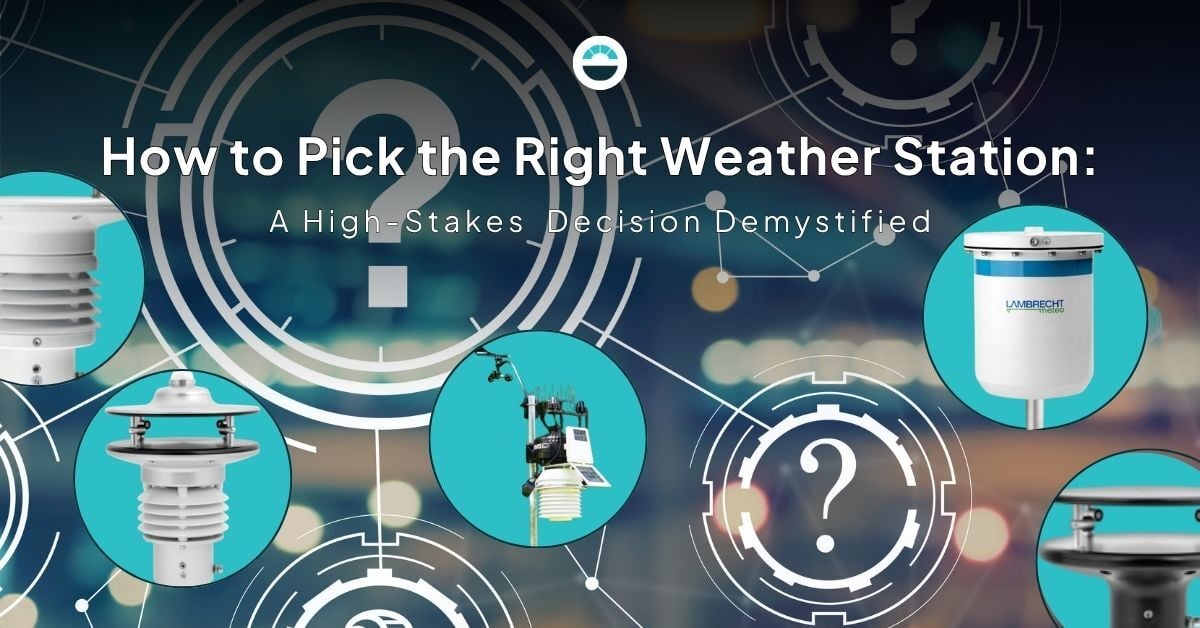
Weather impacts every sector—schools, farms, utilities, ports, and beyond. But while the need for reliable data is universal, the path to getting it isn’t.
Although choosing a weather station might seem straightforward, the decision quickly becomes complicated by factors like location, maintenance, data requirements, and regulatory standards. Get the choice wrong, and it can mean costly downtime, safety risks, and dangerous blind spots.
To make that complexity more manageable, this blog distills key insights from one of AEM’s recent webinars. Through short video highlights and a visual guide, you’ll see how local realities and operational demands shape station choice, and how AEM’s portfolio is structured to help you navigate the options with confidence.
Weather is always local
Ask anyone why they need a weather station, and the answer usually starts with this: they want to know their weather, not the airport’s. A frost pocket in an orchard row or a heat spike on a school field could easily be missed by a regional source. Hyperlocal ground truth is what matters.
AEM's hardware product management lead, Russ Heilig, drives home the point this way: the number that matters most is the one measured right where you stand. Once you hear his take in this clip, you won’t think about “local weather” the same way again.
Same variables, different demands
Every sector depends on the same core weather variables—temperature, wind, rainfall, and more—but the realities of collecting that data differ dramatically.
At a school, staff can readily maintain weather stations that help protect students from heat stress, severe weather, and lightning during outdoor recess, gym classes, or after-school activities. Contrast that with a coastal port, where stations feed mission-critical decisions that safeguard both people and cargo. There, even brief downtime for unplanned maintenance could mean costly disruption or dangerous blind spots.
That contrast shows why station choice is never just about the data itself—it’s about the realities of collecting it, and the consequences of acting on it.
A framework for choosing the right station
When it comes time to choose a station, multiple factors come into play. Each adds a layer of complexity that can make the decision feel overwhelming.
In the clip below, Russ frames these considerations through the lens of the five W’s (who, what, where, when, and why), making the point that station choice isn’t just about hardware. It’s about people, places, priorities, and ultimately the decisions that data must support.
A framework like this may not eliminate the complexity, but it helps cut through the noise, clarifying which factors matter most in your situation and which trade-offs you can live with.
One portfolio for many missions
Even with a framework, sorting through the sheer variety of weather stations can feel daunting. That’s why AEM has organized its portfolio into clear tiers, each aligned with a range of use cases—from everyday monitoring to industrial resilience to research-grade networks.
In this segment, you’ll see how the portfolio brings order to complexity, showing how a broad set of options can be grouped into levels that make sense. It’s a way to cut through the noise and focus on the tier that best fits your environment and priorities.
The tiers don’t exist in the abstract—they line up with real-world needs. This infographic connects representative use cases to the tier that best supports them, highlighting the factors that tip the balance. For some, it’s ease of upkeep; for others, resilience in harsh environments or compliance with international standards.
The takeaway: you don’t have to start from scratch. The portfolio narrows the field, so you can focus your attention where it matters most.
| Use Cases | Recommended AEM Weather Station Line | Primary Needs Served | Key Features |
| Schools | Vantage |
safety, operational decision-making, stakeholder communication, asset protection, production optimization | affordability, reliability, simplicity, low maintenance, flexible power/telemetry options, modular sensors |
| Parks | |||
| Municipalities | |||
| Farms | |||
| Construction Sites | |||
| Cubs/Sports Venues | |||
| Energy Utilities/ Renewable Energy | Ascend |
capacity calculations, capacity optimization, remote use, production forecasting, business continuity, asset protection, navigational safety, operational efficiency, worker/passenger safety, regulatory compliance, scalability | grid integration, defensible data for compliance, designed for harsh conditions like seawater environments, nav system integration, sensor redundancy, ICAO-compliant |
| Maritime Ports/ Shipping |
|||
| Aviation | |||
| Airport Ground Operations | |||
| Mines | |||
| National Meteorological /Hydrological Agencies | Apex |
highest degree of accuracy, integration with national and international networks, data security, reliable and precise inputs for precision routing, optimized mission planning & logistics | research-grade sensors, compliance with international interoperability standards, secure and scalable data logging, rugged construction for harsh environments like saltwater, sensor redundancy, WMO- and ICAO-compliant |
| Research Institutions | |||
| Mesonets | |||
| Government/ Defense Organizations |
Bringing it all together
The clips above touch on the “why” and “what” of weather station choice, but the full session goes deeper into the “how”—from frameworks to tiered builds to software workflows that turn observations into decisions. You’ll also hear how AEM Elements® 360 complements the hardware by centralizing station data alongside radar, satellite, and models, creating one place to monitor conditions and trigger smart alerts.
Watch the full webinar to see how these pieces fit together—and to get practical guidance you can use to avoid missteps and scope a weather monitoring network you can trust.